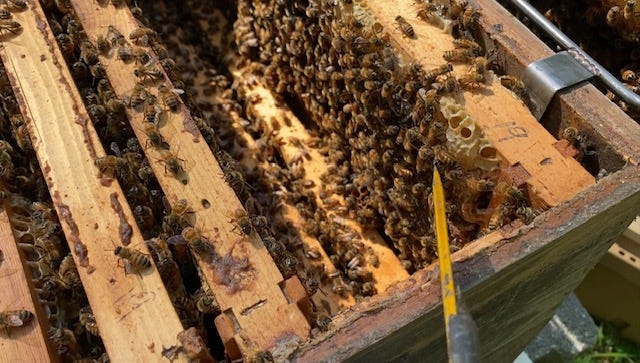We’re getting closer to the blog’s 1-year anniversary. This week’s news: I’m developing a poetry cookbook with ingredients sourced from the hive. I’m shooting for publication in the spring of 2025. As some of you may know, all of my 1-pound and larger honey jars include my original bee poetry. While honey is an obvious ingredient in the recipes, I’m also developing recipes that include other products from the hive like pollen, beeswax, and propolis. As you’re already familiar with my passion for evidence-based health resources, you’ll find that will be a familiar theme in the book too. Now, more about the flavors and science of propolis…
Propolis is a special substance that honey bees create from tree resins. Check out my earlier post all about propolis for immunity, plus I cover skincare uses, where it’s found in the hive, how it’s harvested, and what the bees use it for.
The edible application for humans provides many health benefits. One study shows that propolis extracts were more effective than antibiotics on Gram-positive bacteria. Published in 2021 in the Saudi Journal of Biological Sciences, “Propolis acts either by directly interacting with the microbial cells or by stimulating the immune system of the host cells.” Research published a year later in Molecules suggests that propolis not only helps combat bacteria, but also fungi and viruses. And a study published just this year in the International Journal of Pharmaceutical and Bio-Medical Science showed that propolis extracts in alcohol were more effective against certain fungi than one dissolved in water.

What does it taste like to consume propolis as an extract? Or raw? Or in pill form? As an alcohol extract, I feel propolis tastes like a floral explosion. After I have a few drops, I feel like I’m breathing flowers. Creating an alcohol-based tincture helps extend the use of propolis and draws out important properties. For example, a dime-sized piece of propolis could be consumed in one gulp, whereas creating a tincture with the same amount could create a small dropper bottle with dozens (if not in excess of a hundred) of uses for many years. This allows for ongoing health support if consumed regularly, plus opportunities for concentrated doses during illnesses.
Eating propolis raw can be done a few ways. Sucking and chewing on it allows saliva to breakdown certain components through digestion. However, propolis is incredibly sticky and could easily cause dental issues if someone has fillings, braces, or something similar. It also stains pretty much every surface it touches with a yellowish tinge, so not culturally ideal for folks trying to preserve a bright, white smile. You could take a small piece of propolis and swallow it like a pill to avoid the teeth yellowing. You could also sprinkle it in a smoothie or on yogurt. I haven’t had propolis in pill form, but that would help avoid the potential teeth-staining as well.
As far as taste, it can range depending on the tree sources the bees relied on to create it.
I’m reading Raising Resilient Bees by Eric and Joy McEwen. According to the book:
“honey bees gather the lion’s share of resin from poplar or cottonwood trees when they are in the vicinity. Collectively these types of propolis are known as poplar propolis. In most assays we have reviewed, poplar propolis sets the standard in that it always appears to have the same or even superior antimicrobial activity or higher concentrations of known active ingredients when compared with other propolis from different parts of the world.”
I was pleased to read this because the tulip poplar is the primary nectar source for my Piedmont apiary, which would imply that the same trees would also be primary propolis sources for the hives too. I’ve only tasted raw propolis once and it was a little bitter, but I’ve heard other folks in different regions describe it as sweet. It must truly depend on the tree sources.
Aside from taste, propolis smells sweet and floral. Whenever friends walk into my bee supply room, they comment how good it smells. That’s mainly thanks to the bees covering frame edges and interiors of hive bodies with propolis. I always make a point to breathe in the aromas from the hives when I’m inspecting them. It not only helps me understand what’s coming into bloom (aster smells rank), but breathing the aromatics of the hive provides immune support. Inhaling the aromas from beehives is a form of apitherapy and has a number of health benefits I’ll cover in another post at another time.
Have you had raw propolis? What do you think it tastes like?





I’m preordering your book! This sounds like a perfect collaboration of your knowledge and creativity!